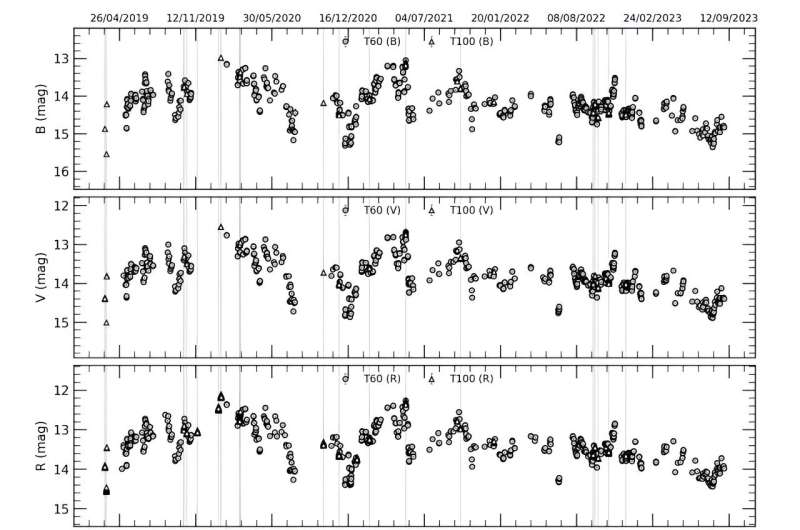July 22, 2024 report
This article has been reviewed according to Science X's editorial process and policies. Editors have highlighted the following attributes while ensuring the content's credibility:
fact-checked
preprint
trusted source
proofread
Study investigates optical variability of blazar S5 0716+714

Using the TÜBİTAK National Observatory, astronomers from Turkey and India have observed a bright blazar known as S5 0716+714. Results of the observational campaign, published July 12 on the pre-print server arXiv, yield essential information regarding the optical variability of this blazar.
Blazars are very compact quasars associated with supermassive black holes (SMBHs) at the centers of active, giant elliptical galaxies. They belong to a larger group of active galaxies that host active galactic nuclei (AGN), and are the most numerous extragalactic gamma-ray sources. Their characteristic features are relativistic jets pointed almost exactly toward the Earth.
Based on their optical emission properties, astronomers divide blazars into two classes: flat-spectrum radio quasars (FSRQs) that feature prominent and broad optical emission lines, and BL Lacertae objects (BL Lacs), which do not.
S5 0716+714 is a blazar at a redshift of 0.23, first discovered in 1979 as part of a survey of extragalactic radio sources. It is one of the brightest and most active BL Lacs so far detected.
S5 0716+714 showcases extreme optical variability, and due to this, it has been the subject of several optical monitoring campaigns. The most recent of them has been conducted by a group of astronomers led by Ergün Ege of Istanbul University. For this purpose, they employed TÜBİTAK National Observatory's T60 and T100 telescopes.
"We present the results of the observational study of the blazar S5 0716+714 in the optical bands B, V, R, and I between March 2019 and August 2023 to investigate its variability on diverse timescales," the researchers wrote.
The observations found that the brightness of S5 0716+714 varied between 12.11 and 14.58 in the optical R-band. Moreover, the long-term light curve shows that the blazar had a variability amplitude of approximately 256.12, 247.08, 247.04, 230.21 percent in the B, V, R, I bands, respectively.
When it comes to the intraday variability (IDV), the results indicate that S5 0716+714 was significantly variable in the R-band on 12 out of 21 observing nights. On those days, the blazar had a significant IDV with a magnitude change of approximately 0.1 mag and a variability amplitude between 4.41 and 11.23 in the BVRI bands.
The study found that S5 0716+714 likely has quasi-periods of about 186 and 532 days in the R-band light curve. The astronomers assume that the 186-day quasi-period oscillation (QPO) points to two outbursts of the blazar that may have taken place in May and October 2021.
Based on the collected data, the authors of the paper were also able to calculate that the size of the emission region in S5 0716+714 is some 67 AU and that the mass of the blazar's SMBH is at a level of 569 million solar masses.
More information: Ergün Ege et al, Investigating Optical Variability of the Blazar S5 0716+714 On Diverse Time-scales, arXiv (2024). DOI: 10.48550/arxiv.2407.09419
Journal information: arXiv
© 2024 Science X Network





















